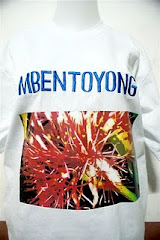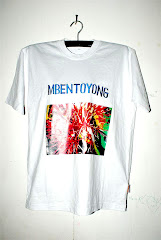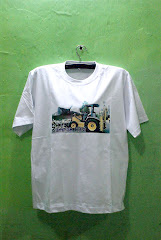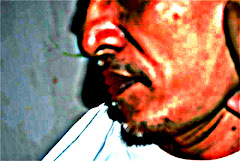.JPG)
.JPG)
.JPG)
The Museum of The Unworthy
Cemeti Art House
Tuesday, June 16, 2009 at 7:30pm
Wednesday, June 24, 2009 at 5:00pm
Yogyakarta
Jl. D.I Panjaitan 41
Yogyakarta, Indonesia
.JPG)
.JPG)
.JPG)
.JPG)
.JPG)
Cemeti Art House
Tuesday, June 16, 2009 at 7:30pm
Wednesday, June 24, 2009 at 5:00pm
Yogyakarta
Jl. D.I Panjaitan 41
Yogyakarta, Indonesia
.JPG)
.JPG)
.JPG)
.JPG)
.JPG)
Description
THE MUSEUM OF THE UNWORTHYA creative engagement with Piyungan Landfill, JogyakartaNindityo Adipurnomo - Ferial Afiff - M. Lugas Syllabus - Anang Saptoto - Cassandra Schultz - Ned Branchi - Hedi Hariyanto - Tony Maryana - Andita Purnama“In an unproblematic sense garbage is leftover matter, it is what remains when the good, fruitful, valuable, nourishing and useful has been taken. Appropriation is the mother of garbage.In another guise this is seen as human propensity for differentiation (a complicated way of saying we choose or accept something whilst rejecting something else) that inaugurates a lifetime of cutting-off, disconnection and removal. Nevertheless, these activities become the principal means of marking of the valuable and the worthy, and this sense differentiation is what establishes culture.” (Scanlan, John On Garbage ReaktionBooks, London, 2005 pg 13)When I first saw a photograph of Piyungan a few years ago, I was struck by the resemblance the cattle and people sifting though the waste bore to Van Gogh’s Gleaners. The image was almost idyllic until closer inspection revealed the nature of the matter from which this landscape was composed, a landscape of garbage. Gleaning was once a practice undertaken by the poor in Europe, following the harvest and collecting unwanted leftovers. This practice has virtually disappeared in industrialized nations. Fascinated by the difference between the barren and invisible landfill sites in my own country, and the chaotic and inhabited landscape of Piyungan, I determine to come and see this place for my self.That people and cattle should live and work amongst waste raises the questions of how all this stuff came to be discarded, when it obviously still contain much that is sustaining and of value. The scale of the waste is awe inspiring; it is in installation of major proportion, made up of the most intriguing and disgusting items juxtaposed in random relationships that bear no reference to their origins.In conversations with a local I was told a mountain of waste could be as deep as 500 meters and covers an area of around 80 acres . in 2010, the site is anticipated to be unable to hold anymore, and the steady stream of garbage truck will cease to bring their loads. Much of this waste is plastic and will never biodegrade. The piyungan mountain of waste will remain as a monument to consumption, to loss of desire.Finally standing on this mountain, I began to see my position in relation to this place, and to the role of the artist in creating desire, consumption and excess and ultimately, waste. To consider the commoditization of art itself, where the reputation of the artist, the dealer, the gallery, replace and over ride intent and original message contained in the work of art, if ever there was one. In tracing the hand of the artist, the designer, the manufacture, the trader and the consumer, the constant desire to upgrade and replace worthy commodities maybe revealed.In relation to this, I invited a number of artist to come with me to piyungan landfill site and make works which responded to these notions. Each artist has responded in differently and intersected with the underlying themes in diverse and complex ways. Each has found experience of actually visiting and standing of this mountain of waste, amongst the people and the animals that leave there, to be challenging, revealing and inspiring. In presenting their works. We hope to share this with a broader audience and inspire a dialogue which resonates beyond the gallery walls.Cassandra Lehman-Schultz, artist in residence, Cemeti Art House, Jogjakarta, March-June 2009This is an Asialink Project funded by the Australia Indonesia Institute and arts Queensland.Let’s do barbeque(Nindityo Adipurnomo, visual artist - based in Yogyakarta)Although the theme has occurred incidentally through curatorial discourses and artistic practice, environmental issues have never been a primary concern for the contemporary arts in Indonesia. After visiting the landfill site at Piyungan, my response to the issues contained here was radically shifted towards a personal confrontation with my own habits and interactions with the local cyclic economics of commodification. I am confronted by the notion of survival in this toxic and highly offensive environment, when all other choices have been removed.Human Presence(Ferial Afiff, artist – based in Yogyakarta)When I first visited Piyungan. I was proud of the industrious efforts of the many people working to manually recycle the garbage. These efforts are valuable in that they create income as well as reducing waste. Then, while walking on the garbage itself, I began to see in detail the traces of the many hands involved in creating, using and discarding the materials. I see the human essence as present in the garbage itself.Cow(M. Lugas Syllabus, visual artist – based in Yogyakarta)Each species on earth has a time to live and a time to die. Imagine the fossils of the creatures from our time in the museums of the future. We are what we eat! I imagine the fossil of the Piyungan cow that eats garbage every day. This work is about the future, about what we present to the next generation.Fresh Milk(Anang Saptoto, visual artist – based in Yogyakarta)Hundreds of the cows living in Piyungan Landfill and eating garbage will be sold for their meat. We will never know for sure where these cows go. Is it possible that the animals turned into satay, tongseng, steak, cow’s rib or other tasty meals made from cows’ meat that come from Piyungan Landfill? Amidst the garbage, I came across hundreds of various kinds of fresh milk packaging. I was attracted to this particular brand with its picture showing a cow with green mountain background. For me, the scenery being pictured on the box was similar to what I faced in Piyungan. The difference being that instead of an idyllic pastoral scene, it is a mountain of garbage.The Museum of the Unworthy(Cassandra Schultz, Asialink artist in residence – based in Australia)I see the site of the landfill at Piyungan as the last bastion of colonialism in this region., the legacy of centuries of trade and design from the first world. I am examining my position as a foreigner in relation to this mountain of waste and the people and animals who live amongst it. I seek to claim some responsibility for the creation of desire, excess, consumption and waste.Garbage Man(Ned Branchi, musician – based in Australia)Pop music is a consumable, disposable commodity. Garbage Man combines grunge guitar and Saron, an instrument I first played as part of a gamelan orchestra in Australia. The references are personal and relate to the overall project, to my own position in relation to my being in Jogyakarta, to the site at Piyungan and to my experiences of each of the other participants in discovering their relationship to this place and the underlying themes.Clean(Hedi Hariyanto, visual artist- based in Yogyakarta)There are many problems concerning waste management in Indonesia. People attempt to remain clean by removing trash to ‘somewhere else’ where they are no longer associated with it or responsible for it. When I saw the landfill at Piyungan, I thought about how this waste will reappear ‘somewhere else’ as the toxins contaminate the soil in the valley below and are absorbed by the cows who eat from the garbage.Piyungan Suite(Tony Maryana, composer- Based in Yogyakarta)This interactive work will bring together 3 disparate sources which are never otherwise combined; the sound of landfill, the human voice and the rebab : a traditional Javanese instrument. Like the landfill site, this works combines elements from anywhere, without consideration for the original identities or relationships between these elements, before they became defined as ‘waste’.Sign of the Time (Andita Purnama, visual artist – based in Jogyakarta)I see the passion and desire of humans, strewn and accumulated as far my eyes can see, at the Piyungan Landfill. Garbage traced as such, as objects, once connected to people, opened my mind to reveal a garbage history that hides in garbage land layers, which has now become as a solid land to stand on.In this work, I am interested to explore the signs of garbage in order to trace the multiple identities of the owners from the past.
THE MUSEUM OF THE UNWORTHYA creative engagement with Piyungan Landfill, JogyakartaNindityo Adipurnomo - Ferial Afiff - M. Lugas Syllabus - Anang Saptoto - Cassandra Schultz - Ned Branchi - Hedi Hariyanto - Tony Maryana - Andita Purnama“In an unproblematic sense garbage is leftover matter, it is what remains when the good, fruitful, valuable, nourishing and useful has been taken. Appropriation is the mother of garbage.In another guise this is seen as human propensity for differentiation (a complicated way of saying we choose or accept something whilst rejecting something else) that inaugurates a lifetime of cutting-off, disconnection and removal. Nevertheless, these activities become the principal means of marking of the valuable and the worthy, and this sense differentiation is what establishes culture.” (Scanlan, John On Garbage ReaktionBooks, London, 2005 pg 13)When I first saw a photograph of Piyungan a few years ago, I was struck by the resemblance the cattle and people sifting though the waste bore to Van Gogh’s Gleaners. The image was almost idyllic until closer inspection revealed the nature of the matter from which this landscape was composed, a landscape of garbage. Gleaning was once a practice undertaken by the poor in Europe, following the harvest and collecting unwanted leftovers. This practice has virtually disappeared in industrialized nations. Fascinated by the difference between the barren and invisible landfill sites in my own country, and the chaotic and inhabited landscape of Piyungan, I determine to come and see this place for my self.That people and cattle should live and work amongst waste raises the questions of how all this stuff came to be discarded, when it obviously still contain much that is sustaining and of value. The scale of the waste is awe inspiring; it is in installation of major proportion, made up of the most intriguing and disgusting items juxtaposed in random relationships that bear no reference to their origins.In conversations with a local I was told a mountain of waste could be as deep as 500 meters and covers an area of around 80 acres . in 2010, the site is anticipated to be unable to hold anymore, and the steady stream of garbage truck will cease to bring their loads. Much of this waste is plastic and will never biodegrade. The piyungan mountain of waste will remain as a monument to consumption, to loss of desire.Finally standing on this mountain, I began to see my position in relation to this place, and to the role of the artist in creating desire, consumption and excess and ultimately, waste. To consider the commoditization of art itself, where the reputation of the artist, the dealer, the gallery, replace and over ride intent and original message contained in the work of art, if ever there was one. In tracing the hand of the artist, the designer, the manufacture, the trader and the consumer, the constant desire to upgrade and replace worthy commodities maybe revealed.In relation to this, I invited a number of artist to come with me to piyungan landfill site and make works which responded to these notions. Each artist has responded in differently and intersected with the underlying themes in diverse and complex ways. Each has found experience of actually visiting and standing of this mountain of waste, amongst the people and the animals that leave there, to be challenging, revealing and inspiring. In presenting their works. We hope to share this with a broader audience and inspire a dialogue which resonates beyond the gallery walls.Cassandra Lehman-Schultz, artist in residence, Cemeti Art House, Jogjakarta, March-June 2009This is an Asialink Project funded by the Australia Indonesia Institute and arts Queensland.Let’s do barbeque(Nindityo Adipurnomo, visual artist - based in Yogyakarta)Although the theme has occurred incidentally through curatorial discourses and artistic practice, environmental issues have never been a primary concern for the contemporary arts in Indonesia. After visiting the landfill site at Piyungan, my response to the issues contained here was radically shifted towards a personal confrontation with my own habits and interactions with the local cyclic economics of commodification. I am confronted by the notion of survival in this toxic and highly offensive environment, when all other choices have been removed.Human Presence(Ferial Afiff, artist – based in Yogyakarta)When I first visited Piyungan. I was proud of the industrious efforts of the many people working to manually recycle the garbage. These efforts are valuable in that they create income as well as reducing waste. Then, while walking on the garbage itself, I began to see in detail the traces of the many hands involved in creating, using and discarding the materials. I see the human essence as present in the garbage itself.Cow(M. Lugas Syllabus, visual artist – based in Yogyakarta)Each species on earth has a time to live and a time to die. Imagine the fossils of the creatures from our time in the museums of the future. We are what we eat! I imagine the fossil of the Piyungan cow that eats garbage every day. This work is about the future, about what we present to the next generation.Fresh Milk(Anang Saptoto, visual artist – based in Yogyakarta)Hundreds of the cows living in Piyungan Landfill and eating garbage will be sold for their meat. We will never know for sure where these cows go. Is it possible that the animals turned into satay, tongseng, steak, cow’s rib or other tasty meals made from cows’ meat that come from Piyungan Landfill? Amidst the garbage, I came across hundreds of various kinds of fresh milk packaging. I was attracted to this particular brand with its picture showing a cow with green mountain background. For me, the scenery being pictured on the box was similar to what I faced in Piyungan. The difference being that instead of an idyllic pastoral scene, it is a mountain of garbage.The Museum of the Unworthy(Cassandra Schultz, Asialink artist in residence – based in Australia)I see the site of the landfill at Piyungan as the last bastion of colonialism in this region., the legacy of centuries of trade and design from the first world. I am examining my position as a foreigner in relation to this mountain of waste and the people and animals who live amongst it. I seek to claim some responsibility for the creation of desire, excess, consumption and waste.Garbage Man(Ned Branchi, musician – based in Australia)Pop music is a consumable, disposable commodity. Garbage Man combines grunge guitar and Saron, an instrument I first played as part of a gamelan orchestra in Australia. The references are personal and relate to the overall project, to my own position in relation to my being in Jogyakarta, to the site at Piyungan and to my experiences of each of the other participants in discovering their relationship to this place and the underlying themes.Clean(Hedi Hariyanto, visual artist- based in Yogyakarta)There are many problems concerning waste management in Indonesia. People attempt to remain clean by removing trash to ‘somewhere else’ where they are no longer associated with it or responsible for it. When I saw the landfill at Piyungan, I thought about how this waste will reappear ‘somewhere else’ as the toxins contaminate the soil in the valley below and are absorbed by the cows who eat from the garbage.Piyungan Suite(Tony Maryana, composer- Based in Yogyakarta)This interactive work will bring together 3 disparate sources which are never otherwise combined; the sound of landfill, the human voice and the rebab : a traditional Javanese instrument. Like the landfill site, this works combines elements from anywhere, without consideration for the original identities or relationships between these elements, before they became defined as ‘waste’.Sign of the Time (Andita Purnama, visual artist – based in Jogyakarta)I see the passion and desire of humans, strewn and accumulated as far my eyes can see, at the Piyungan Landfill. Garbage traced as such, as objects, once connected to people, opened my mind to reveal a garbage history that hides in garbage land layers, which has now become as a solid land to stand on.In this work, I am interested to explore the signs of garbage in order to trace the multiple identities of the owners from the past.
.jpg)
.jpg)
.jpg)
.jpg)
.jpg)




Tidak ada komentar:
Posting Komentar